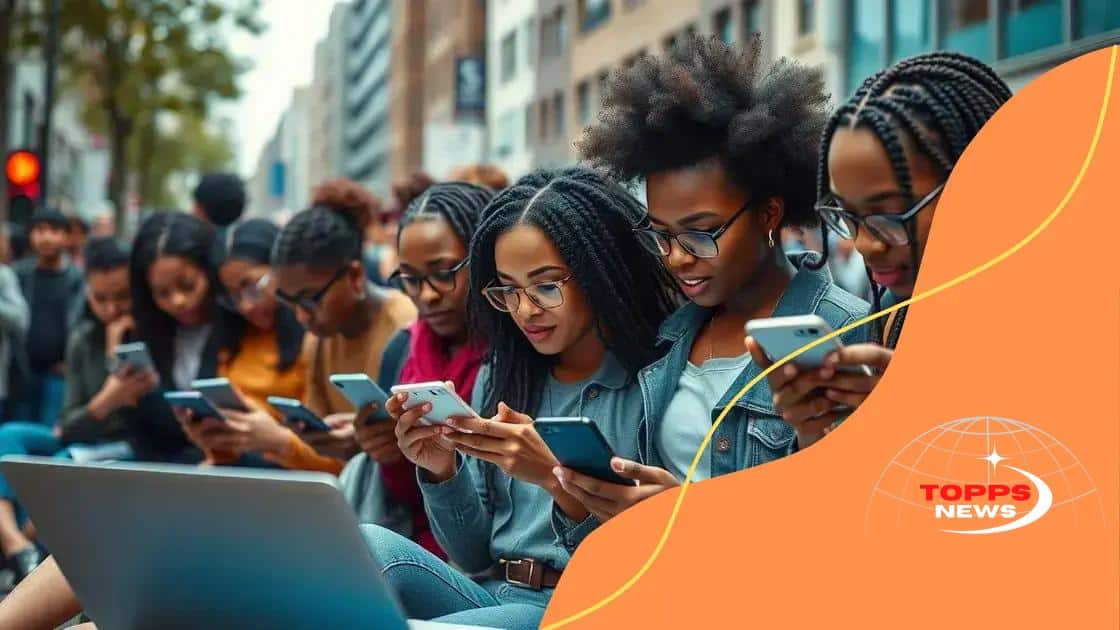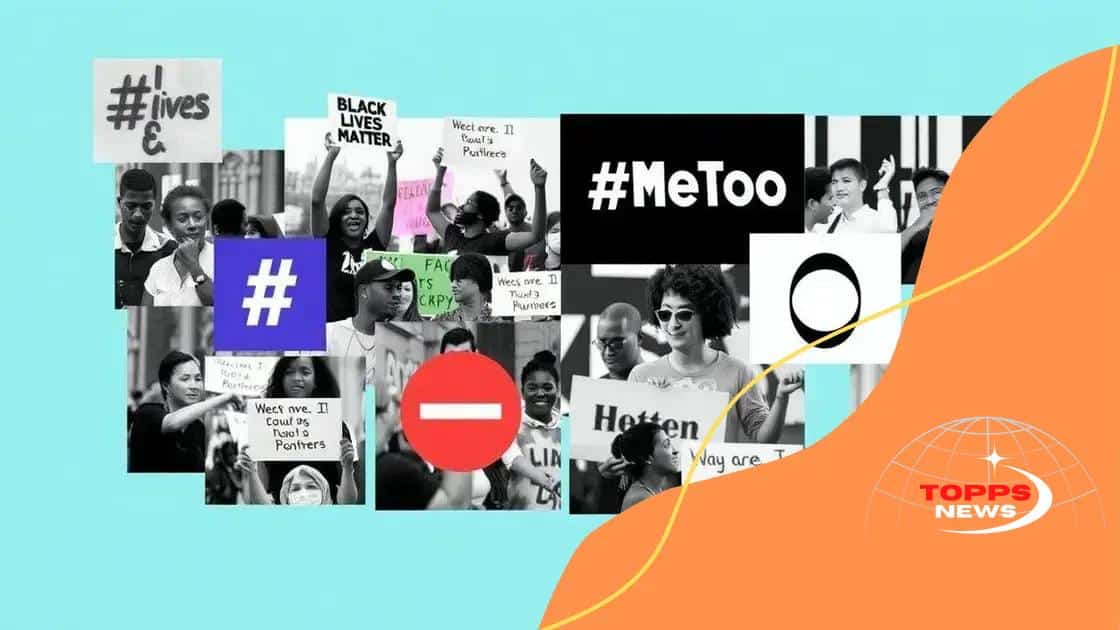Digital activism and social change impact: what you need to know

Digital activism utilizes online platforms and technologies to drive social change, empowering movements through immediate communication, widespread engagement, and innovative strategies for raising awareness about critical issues.
Digital activism and social change impact our lives in ways we might not even realize. Have you ever wondered how a hashtag can spark a global movement? Let’s explore this fascinating intersection together.
Understanding digital activism
Understanding digital activism is crucial in today’s connected world. This form of activism leverages technology to address social issues and promote change.
What is Digital Activism?
Digital activism refers to the use of digital tools to advocate for social change. It can take various forms, including:
- Online petitions
- Social media campaigns
- Blogs and vlogs
- Virtual events and protests
This method allows individuals and organizations to reach wider audiences quickly and effectively. With just a click, a message can spread across the globe.
The Power of Social Media
Social media platforms play a significant role in digital activism. They provide a space for voices that might otherwise go unheard. Activists use channels like Twitter, Instagram, and Facebook to:
- Raise awareness
- Organize communities
- Mobilize support
These platforms make it easier for people to connect, share ideas, and fight for causes that matter to them.
Furthermore, digital campaigns often gain traction through viral trends. Hashtags can turn into movements overnight, bringing attention to vital issues. For example, movements like #BlackLivesMatter and #MeToo have gained momentum online, encouraging discussions and fostering change.
In addition, digital activism can reach millions, inspiring others to take action. This collective effort can lead to significant real-world changes, pushing for reforms and impacting policy decisions.
Understanding digital activism helps us realize the potential of our voices online. Every post, tweet, or share counts. Engaging in online campaigns can inspire others and create a ripple effect of change.
Key platforms for social change
Key platforms for social change are essential in our connected world. These tools enhance communication and enable movements to flourish.
Major Social Media Platforms
Many platforms play a vital role in activism, allowing users to share their messages. Some of the most impactful include:
- Facebook: This platform connects people and groups, making it easy to organize events and share information.
- Twitter: Known for its real-time updates, Twitter is perfect for spreading news quickly, often using hashtags to unite voices.
- Instagram: With a focus on visuals, Instagram helps campaigns reach young audiences through powerful images and stories.
- YouTube: Video content on YouTube educates and engages millions, providing a platform for in-depth discussions and visibility.
These platforms help build communities that rally behind important causes. They serve as a space to exchange ideas, share experiences, and mobilize supporters.
The Rise of Emerging Platforms
While established platforms are crucial, newer ones are also gaining popularity. Apps like TikTok have transformed the landscape of activism. With creative videos, users can convey messages engagingly and entertainingly. This format attracts younger users, expanding the reach of social movements.
Additionally, online forums and discussion boards allow for deeper conversations about social issues. Platforms like Reddit enable users to connect over shared interests and collaborate on solutions.
Understanding these platforms is key to successful advocacy. By leveraging the right tools, activists can engage wider audiences and inspire action. Combining messages across multiple platforms can lead to viral campaigns, significantly influencing public perception and driving change.
Case studies of successful campaigns

Examining case studies of successful campaigns reveals the power of digital activism. These campaigns not only raise awareness but also motivate massive social change.
#BlackLivesMatter
One significant example is the #BlackLivesMatter movement. It began as an online response to violence against Black individuals. By using social media, activists spread awareness about racism and police brutality. The hashtag became iconic, leading to protests worldwide.
Supporters shared stories, images, and facts that highlighted systemic racism. These efforts fostered conversations on difficult topics and motivated many to join the movement.
Another impactful campaign is #MeToo. Started by Tarana Burke, this movement encouraged victims of sexual harassment to share their experiences. It gained traction on social media, empowering countless individuals.
The outpouring of stories created a sense of community among survivors, highlighting the widespread nature of these issues. It led to real discussions about workplace policies and pushed organizations to reevaluate their practices.
These case studies illustrate how digital platforms can amplify voices and drive meaningful change. When communities unite online, they can challenge injustice, instigate conversations, and influence policymakers. As more campaigns gain visibility, the potential for social change expands, showing the real impact that digital activism can have.
The role of social media in activism
The role of social media in activism has grown significantly in recent years. These platforms provide a voice to those who might not have one, allowing movements to gain momentum rapidly.
Connecting Communities
Social media connects diverse communities and fosters collaboration. Activists use platforms like Facebook, Twitter, and Instagram to:
- Share important information and updates.
- Organize events and protests.
- Engage with supporters and like-minded individuals.
This online connection transforms local efforts into global movements. For instance, hashtags can unify people across different countries, rallying them around a common cause.
A Platform for Awareness
Social media serves as a powerful tool for raising awareness about pressing issues. Activists share stories, images, and videos that highlight injustices and call for change. For example, during natural disasters or humanitarian crises, instant updates can mobilize aid and resources.
Furthermore, visuals like infographics and videos capture attention and convey messages effectively. These formats often lead to higher engagement and shareability, allowing important issues to reach wider audiences.
Social media also shapes public opinion, often influencing real-world outcomes. When a campaign gains traction online, it can lead to meaningful discussions on policies and societal norms.
By utilizing social media effectively, activists can amplify their messages, attract supporters, and create significant change. The ability to engage with audiences in real time makes these platforms invaluable for modern activism.
Future trends in digital activism
Future trends in digital activism are shaping the way movements will engage and mobilize supporters. As technology evolves, so do the strategies that activists use.
Emerging Technologies
One significant trend is the integration of emerging technologies. Tools like artificial intelligence (AI) and virtual reality (VR) are becoming vital in campaigns. AI can analyze data to identify key issues and predict trends, allowing activists to tailor their messages effectively.
Moreover, VR can create immersive experiences that raise awareness in unique ways. For example, simulations can help users understand social issues more deeply, sparking empathy and motivating action.
Decentralized Platforms
Another shift is the rise of decentralized platforms. Instead of relying on mainstream social media, activists may turn to decentralized networks, ensuring that their messages remain secure and less susceptible to censorship.
- These platforms allow for free expression and open dialogue.
- They can limit the influence of algorithms that prioritize certain voices.
- Users can have more control over their data and how it’s shared.
This trend empowers activists to connect more authentically with their audiences and to share their stories without fear of suppression.
Focus on Localized Movements
Future digital activism may also emphasize localized movements. While global campaigns are powerful, local actions can lead to tangible change in communities. Activists will leverage digital tools to address specific local issues, encouraging grassroots engagement.
As people become more aware of the impact of their decisions, community-led initiatives may gain momentum. Local campaigns that focus on sustainability, social justice, and public health can create strong bonds among community members.
Overall, the future of digital activism is bright and full of possibilities. As technologies evolve, activists will adapt their strategies to reach and inspire more people than ever before.
FAQ – Frequently Asked Questions about Digital Activism
What is digital activism?
Digital activism is the use of digital tools and platforms to promote social change and advocate for various causes, leveraging technology to engage and mobilize supporters.
How does social media impact activism?
Social media empowers activists to reach a broader audience, facilitate immediate communication, and organize events efficiently, making it a crucial tool for modern movements.
What are some examples of successful digital activism campaigns?
Successful campaigns include #BlackLivesMatter and #MeToo, which have raised awareness on critical social issues and mobilized global support through social media.
What are the future trends in digital activism?
Future trends may involve emerging technologies like AI and VR, decentralized platforms for secure communication, and an increased focus on localized movements to drive community engagement.





